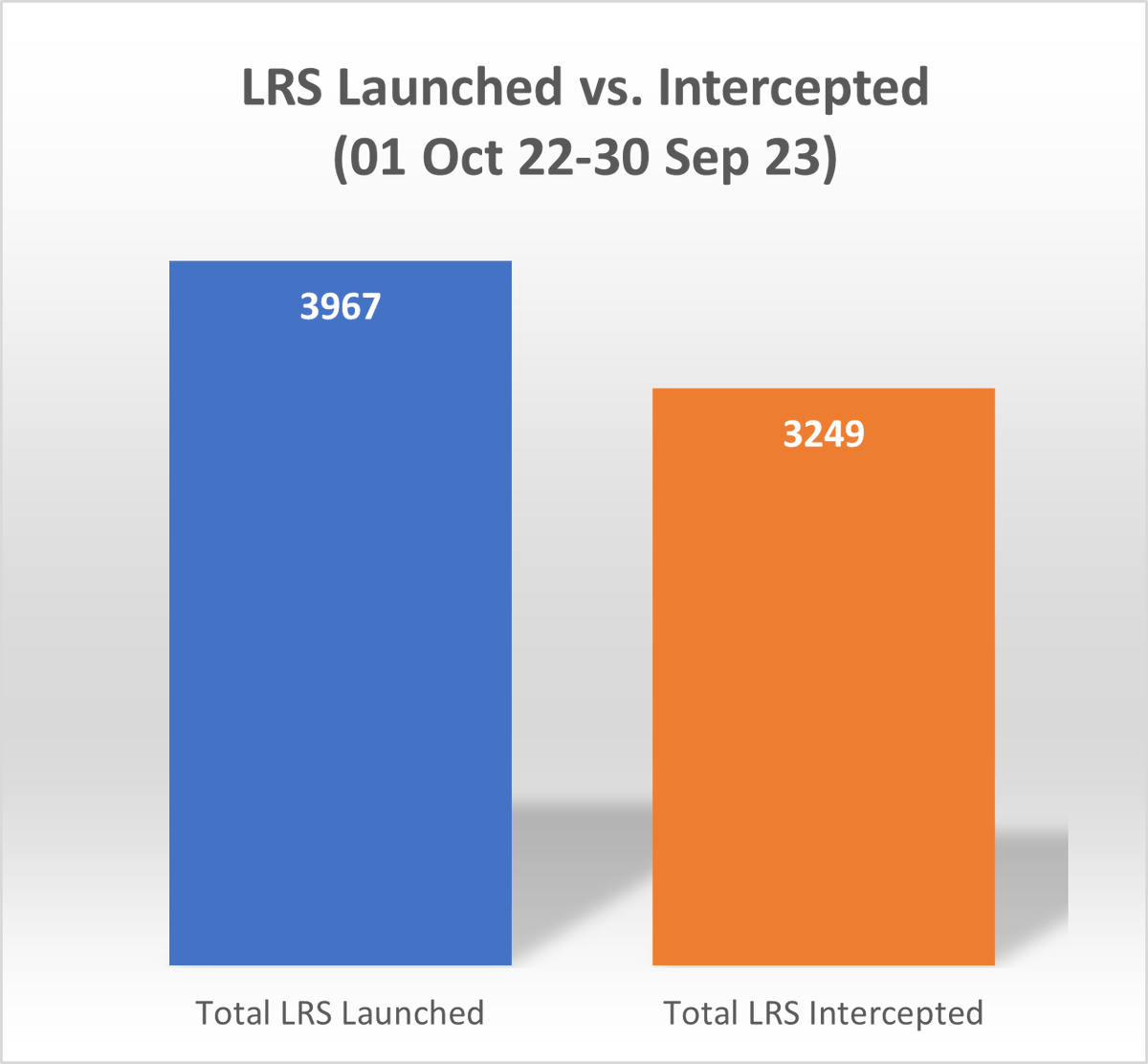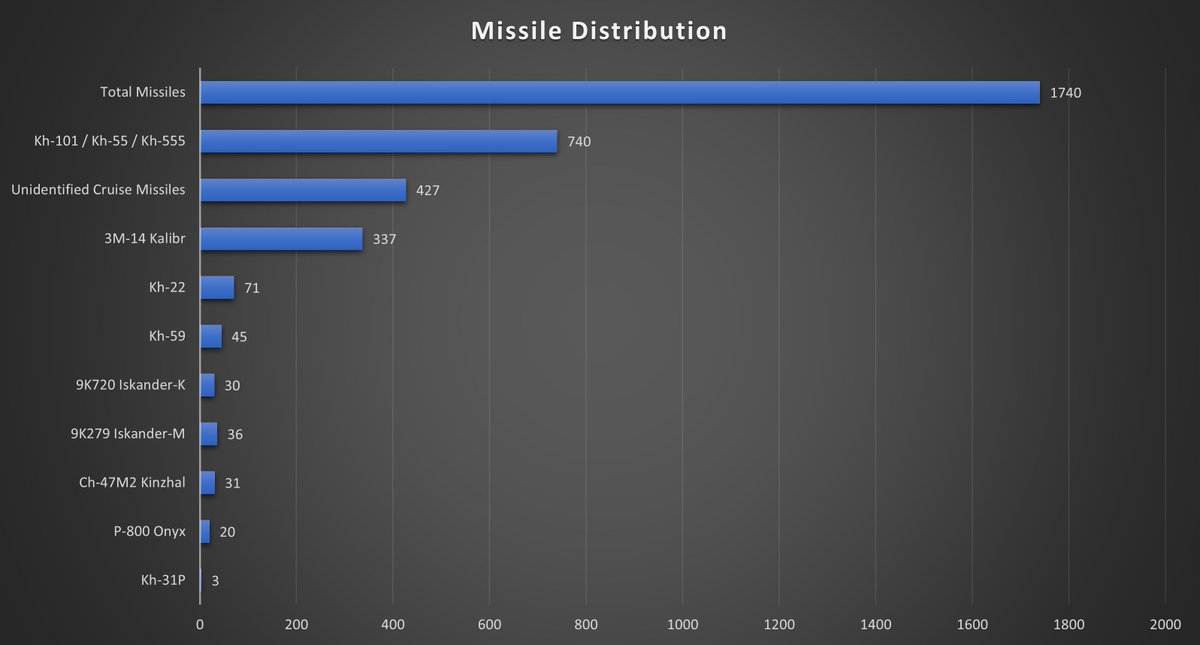Approximately 12 months ago, 🇷🇺 initiated a large-scale long-range strike campaign against Ukraine. I have gathered data on the long-range strike (LRS) weapons employed by Russia and Ukraine's success in intercepting them. This thread provides a summary of the findings. 👇🧵 1/14 

According to official information provided by the Ukrainian Air Force, Russia has launched a minimum of 3,967 long-range strike weapons against Ukraine in the past 12 months. Out of these, 3,249 were successfully intercepted. 2/14 

Please note that this estimate may underestimate the total number of long-range strike weapons launched, while it may potentially overestimate the number of intercepted long-range strike weapons (e.g., the AFU potraying failed launches as successful intercepts). 3/14
In any case, these numbers indicate the staggering amount of ammunition consumed in modern warfare. Contemporary wars are missile wars. States must adapt and prepare accordingly, investing in both their own offensive strike capabilities and defensive countermeasures. 4/14
The first intense period occurred during Winter 22/23 when 🇷🇺 targeted Ukraine's electrical infrastructure, predominently using cruise missiles. The highest number of LRS launched in a single day also occured during this period, with Russia launching 131 LRS on 17 Nov 22. 5/14 

The intensity of long-range strikes decreased from Jan-Apr 23, but picked up again in May. Sep 23 was the highest month in terms of LRS launched. However, it is evident that the use of cruise missiles in these attacks has decreased, likely due to stockpile shortages. 6/14
The total count of long-range strike weapons launched can be categorized as follows: 2,227 long-range drones (Shahed 136) (56.1%), 1,673 cruise missiles (42.2%), and 67 ballistic missiles (1.7%). 7/14 

On average, Ukraine has managed to intercept 87.2% of launched long-range drones, 76.5% of launched cruise missiles, and 41.8% of launched ballistic missiles. 8/14 

Looking at the total number of launched missiles, the majority of missile systems used were Kh-101/Kh-55/Kh-555 (740) and 3M-14 Kalibr (427) missiles. It is highly probable that the "unidentified missile" category mainly consists of these two types of missiles as well. 9/14 

Ukraine achieved great success in intercepting subsonic cruise missiles (Kh-101/55/555, 3M-14 Kalibr, & Kh-59), moderate success in intercepting ballistic missiles (Iskander-M & Kinzhal), and low to no success in intercepting supersonic cruise missiles (P-800 Onyx & Kh-22). 10/14 

There is a strong correlation (0.973) between the number of launched & intercepted LRS. I.e., as the number of launched LRS increases, so does the number of intercepted LRS. This indicates that 🇺🇦's missile defense system is capable of defending against largescale attacks. 11/14 

On average, for every additional long-range strike weapon launched, there is an increase of 0.776 in the number of intercepted long-range strike weapons. Note also the high R-squared, which suggests that launched LRS is a strong predictor of intercepted LRS in the model. 12/14 

The implications of this cannot be overstated. It directly challenges a significant portion of the pre-war discourse on missile defense, which argued that missile defense is ineffective, especially when dealing with large-scale and complex missile raids. 13/14
However, these statistics also highlight a gap in 🇺🇦's IAMD capability. At present 🇺🇦 cannot effectively defend against supersonic cruise missiles. Ukraine requires additional Patriot launchers, radars, and interceptors to adequately protect against these types of threats. 14/14
In the upcoming months, I will provide regular updates on these statistics and highlight important developments in light of Russia's forthcoming Winter missile campaign. I will also try to post more on 🔵Sky, so follow me over there if you don't already (same handle).
Note that in post 10 of this thread, the number of intercepted unidentified LRS is higher than the number of launched unidentified LRS. This is because ithe AFU provides more detail on the types of Russian LRS launched, while the information on intercepted LRS is less specific.
• • •
Missing some Tweet in this thread? You can try to
force a refresh











